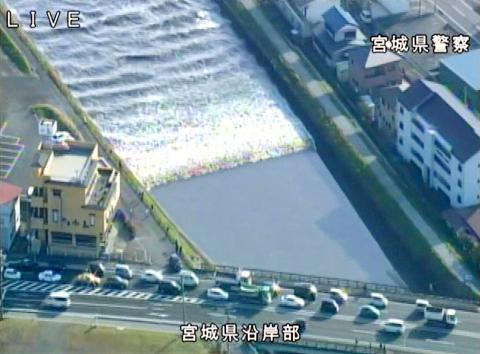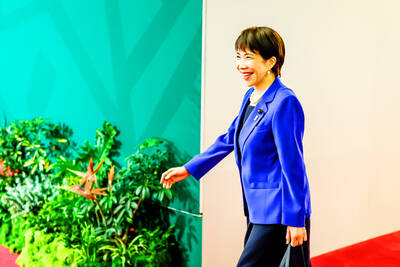At first, it was 2011 all over again.
“It really came back. And it was so awful. The sways to the side were huge,” Kazuhiro Onuki said after northeastern Japan was jolted by a magnitude 7.4 earthquake yesterday, the strongest since a devastating quake and tsunami five years ago.
“But nothing fell from the shelves,” Onuki, 68, said in a phone interview, his voice calm and quiet.

Photo: AP
Coastal residents returned home from higher ground and fishing boats to port, after tsunami warnings were lifted along Japan’s Pacific coast. The earthquake gave Tokyo — 240km away — a good shake, but was much less powerful than the magnitude 9 quake in 2011, and only moderate tsunami waves reached shore.
The Fukushima Dai-ichi nuclear power plant, which leaked radiation for kilometers after the 2011 tsunami, reported no abnormalities. Decommissioning work on the destroyed reactors was suspended and the site inspected.
At least 14 people were reported injured, three with broken bones, and Japanese TV showed items scattered on the floor in a store and books fallen from shelves in a library.
On the coast, lines of cars snaked away in the pre-dawn darkness after authorities urged residents to seek higher ground immediately.
The first tsunami waves hit about an hour later. The highest one, at 1.4m, reached Sendai Bay about two hours after the quake. By comparison, the waves in 2011 were 10m to 20m high.
The evacuation appeared to proceed calmly.
It was the largest earthquake in northeastern Japan since the one in 2011 and some large aftershocks the same day.
The US Geological Survey measured Tuesday’s quake at a lower magnitude 6.9.
The Japan Meteorological Agency described it as an aftershock of the 2011 quake, which triggered tsunami that killed about 18,000 people and wiped out entire neighborhoods.
“Aftershocks could continue not only for five years, but as long as 100 years,” Kyoto University seismologist Yasuhiro Umeda said on Japanese broadcaster NTV.
In some areas, water could be seen moving up rivers, which funnel the waves to even greater heights, but remained well within flood embankments.
Tokyo Electric Power Co (TEPCO), the utility that operates the Fukushima plant, said a swelling of the tide of up to 1m was detected offshore.
The plant is being decommissioned after 2011 tsunami sent three of its reactors into meltdown, but the site remains at risk as the utility figures out how to remove still-radioactive fuel rods and debris and what to do with the melted reactor cores.
TEPCO said a pump that supplies cooling water to a spent fuel pool stopped working, but a backup pump was employed after about 90 minutes, and the temperature rose less than 1°C.
TEPCO decommissioning unit director Naohiro Masuda said he believes a safety system shut off the pump automatically as the water in the pool shook.

LIMITS: While China increases military pressure on Taiwan and expands its use of cognitive warfare, it is unwilling to target tech supply chains, the report said US and Taiwan military officials have warned that the Chinese People’s Liberation Army (PLA) could implement a blockade within “a matter of hours” and need only “minimal conversion time” prior to an attack on Taiwan, a report released on Tuesday by the US Senate’s China Economic and Security Review Commission said. “While there is no indication that China is planning an imminent attack, the United States and its allies and partners can no longer assume that a Taiwan contingency is a distant possibility for which they would have ample time to prepare,” it said. The commission made the comments in its annual

DETERMINATION: Beijing’s actions toward Tokyo have drawn international attention, but would likely bolster regional coordination and defense networks, the report said Japanese Prime Minister Sanae Takaichi’s administration is likely to prioritize security reforms and deterrence in the face of recent “hybrid” threats from China, the National Security Bureau (NSB) said. The bureau made the assessment in a written report to the Legislative Yuan ahead of an oral report and questions-and-answers session at the legislature’s Foreign Affairs and National Defense Committee tomorrow. The key points of Japan’s security reforms would be to reinforce security cooperation with the US, including enhancing defense deployment in the first island chain, pushing forward the integrated command and operations of the Japan Self-Defense Forces and US Forces Japan, as

IN THE NATIONAL INTEREST: Deputy Minister of Foreign Affairs Francois Wu said the strengthening of military facilities would help to maintain security in the Taiwan Strait Japanese Minister of Defense Shinjiro Koizumi, visiting a military base close to Taiwan, said plans to deploy missiles to the post would move forward as tensions smolder between Tokyo and Beijing. “The deployment can help lower the chance of an armed attack on our country,” Koizumi told reporters on Sunday as he wrapped up his first trip to the base on the southern Japanese island of Yonaguni. “The view that it will heighten regional tensions is not accurate.” Former Japanese minister of defense Gen Nakatani in January said that Tokyo wanted to base Type 03 Chu-SAM missiles on Yonaguni, but little progress

NO CHANGES: A Japanese spokesperson said that Tokyo remains consistent and open for dialogue, while Beijing has canceled diplomatic engagements A Japanese official blasted China’s claims that Japanese Prime Minister Sanae Takaichi has altered Japan’s position on a Taiwan crisis as “entirely baseless,” calling for more dialogue to stop ties between Asia’s top economies from spiraling. China vowed to take resolute self-defense against Japan if it “dared to intervene militarily in the Taiwan Strait” in a letter delivered Friday to the UN. “I’m aware of this letter,” said Maki Kobayashi, a senior Japanese government spokeswoman. “The claim our country has altered its position is entirely baseless,” she said on the sidelines of the G20 summit in Johannesburg on Saturday. The Chinese Ministry